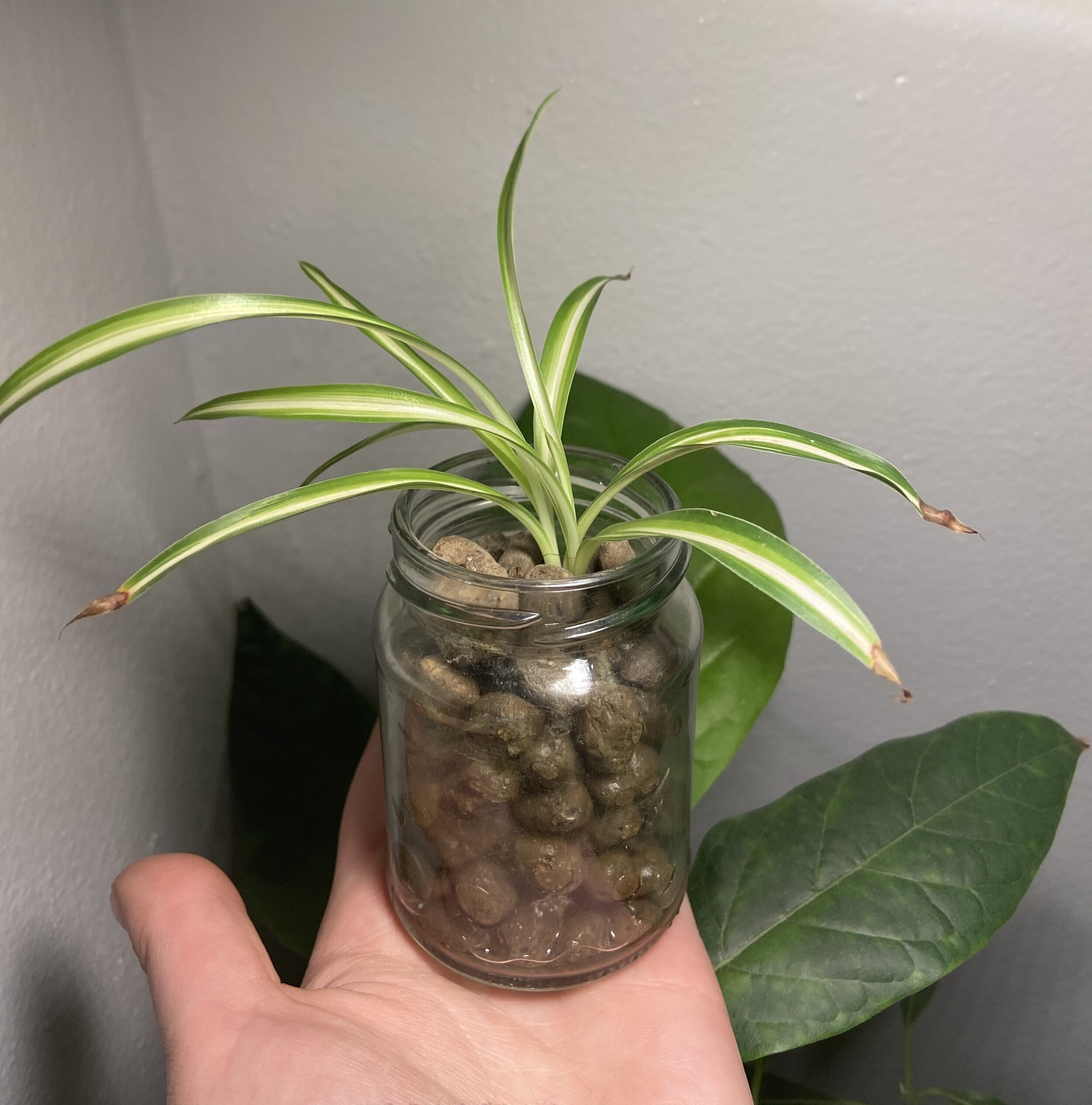Passive hydroponics is a method of growing plants in a soil-less medium with the use of LECA or lightweight, expanded clay aggregate.
Essentially, the plant is placed bare root into the LECA, then a water reservoir is added to the bottom of the medium. The LECA is porous so it wicks the water up from the reservoir at the bottom, keeping the roots evenly moist and well-aerated.
There are many benefits to switching to passive hydroponics. It is an excellent solution if you are facing the inevitable onslaught of fungus gnats that plague houseplant parents in the winter time, and also makes it easier to treat other pests because they can’t hide in the soil and the plant is bare root so it’s super easy to dunk the plant in a pest control solution. The greatest advantages to passive hydroponics in my experience are the fact that the clay pebbles allow air flow around the plant’s roots, significantly lowering the chances of root rot. Another perk is that depending on how you choose to situate your plants with their reservoirs, you can go a lot longer in between waterings; a huge plus for those of us with especially lush indoor jungles.
You might be saying to yourself, “SOLD! LET’S DO IT!!!” But we gotta back it up a little. There are some things about passive hydroponics that make plant parenting a little tricky. The worst part about transitioning to passive hydro by FAR is cleaning the soil off of a plant’s roots. It requires a lot of time and root fondling and is tedious to say the least. Another tricky thing is nutrient management. Because the plant is not in soil getting its nutrients from the medium, nutrients must be added to the water reservoir.
There are varying opinions on which nutrients work best but the most common brands I hear about in the community are General Hydroponics, Fox Farms, and Liqui-Dirt. Personally, I choose to use Fox Farms Grow Big and have seen healthy growth at a reasonable pace. In addition to adding nutrients, the water you add to your reservoir must be pH balanced to allow your plant to properly absorb the nutrients. Kits for this can easily be found online. To get a true expert’s advice on what products to use and how to use them, I would recommend asking someone at your local hydroponics store, which brings me to my next point.
What do you need, and where do you get it?
The materials I use on a regular basis for my passive hydroponic plants are:
◦ LECA (can be found at IKEA, hydroponics stores, reptile stores, and online)
◦ pH balancing kit (found online usually)
◦ Hydroponic nutrients (again, hydroponics stores or online)
◦ Pasta strainer (for rinsing the LECA before use, I recommend finding a used one at a local thrift store so you don’t get clay all over your good pasta strainer)
◦ Five gallon bucket (to catch the water while rinsing LECA, clay and pipes do NOT mix)
◦ Glass vases. Like, a LOT of glass vases. (Thrift stores are great for affordable options)
Ok, so you’ve got everything you need now where do you begin? I hate it to break it to you, but the LECA is going to have to stay in the bag for a few weeks while you prepare your plants for their new semi hydroponic lifestyle. The first step of preparing a plant is cleaning the roots of soil. You want to gently massage the root ball, getting as much soil off as you possibly can. To remove even more thoroughly, many people use their hoses to hit the roots with some major water pressure, getting them nice and squeaky clean. This is a crucial step because now that our plant is going to be constantly exposed to water, any matter stuck to the roots will be constantly wet which will suffocate the roots and cause rot if not removed properly. Once you’ve got the roots nice and clean, you’ll want to place the roots in a vessel of just water. No nutrients, no LECA, just water. This will be a transition period where the soil roots will shed and the plant will put out water roots instead. Some people prefer to go straight to LECA and skip the water only step but I highly recommend sticking to it because dead soil roots are hard to clean out of LECA and much easier to remove from a glass of water. It is also much easier to keep an eye on how your plant is handling the transition.
After a few weeks, you will see much of the old roots have died off and you are left with beautiful fuzzy white water roots. NOW it’s time to bust out your LECA and your pasta strainer. You’ll want to add LECA from the bag to the pasta strainer and rinse thoroughly to remove the clay dust that accumulates on LECA pebbles when they rub against each other. If you do this in your kitchen sink, be sure the water that goes through your LECA goes into a bucket and not down your drain because clay will block your pipes. Some people choose to rinse outside with a hose so the water can seep straight into the ground. Once the water is running clear out of your pasta strainer, the LECA is ready for use.
To plant your plant, you’ll want a vase that’s approximately double the size of your plant’s root ball. Simply fill your container 1/3 of the way with LECA, then hold your plant in the container the way you’d like it to be situated. Fill in the rest of the space in the container with more LECA until your plant and its roots are nice and secure. Sometimes the LECA can have a hard time getting in between the roots so I use a chopstick to gently push it into the gaps. Gaps are a no go because that will stop that section of the roots from being able to absorb water. Now that you have your little friend planted, you want to add a water reservoir. For the first month or so, I recommend using plain water so your plant can continue to adjust and won’t go into shock with the added LECA and fertilizer. Make sure your reservoir is not touching the roots.
For the next month or so, keep a close eye on your plant. You should see fuzzy roots start to stretch down the container towards the reservoir. Some leaf loss is normal. If your plant seems to be adjusting well, you can add your nutrient mixture to the reservoir.
To create the nutrient mixture you simply fill a container with water, use your pH balancing kit to get your water between 5.5 and 6.5. Then, follow the instructions on your chosen fertilizer to properly dilute it for hydroponics. Fill your reservoir to the 1/3 line as before. As time passes, continue keeping an eye on the reservoir in your container and try to prevent it from getting completely empty. Then you’re done!
There are many different ways of doing passive hydroponics, this is simply one plant mom’s opinion and experience and how I’ve seen success converting over 100 plants! I highly recommend doing your own research (YouTube videos are an excellent resource if you have curiosity). Thanks for reading and I hope this helps you get started on your own LECA journey.

